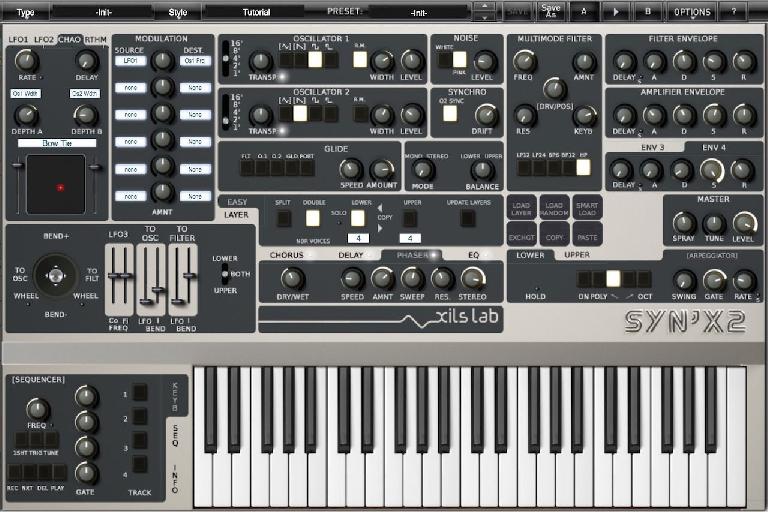As the rich history of analog synthesis continues to dominate the imagination of producers worldwide, it's no surprise to see increasingly rare vintage synths converted into virtual instruments. Italian manufacturer Elka's Synthex was a legendary early '80s analog polysynth powerhouse, famously employed by the likes of Jean-Michel Jarre and Stevie Wonder, among others.
Combining a dual digitally-controlled analog oscillator architecture with pulse-width cross-modulation, 8-voice polyphony, and a four-part sequencer, the mere sight of a Synthex in the wild is liable to cause the average gearhead to salivate uncontrollably. It should therefore come as no surprise that boutique French virtual instrument company XILS-labs have seized a gap in the digital marketplace to faithfully reproduce the Synthex in all its glory for use in the modern DAW—and recently updated it with some key improvements.
Synth'X'is
Syn'X 2's main panel is comprised of a faithful rendition of the Elka original's primary components: a pair of oscillators selectable from triangle, sawtooth, square, and pulse, plus ring modulation and pulse width options, a noise generator, a multimode filter with 12- and 24-pole low and bandpass filters along with a single high-pass curve, a pair of dedicated envelope generators, a pair of LFOs, portamento and glide controls, basic modulation controls, a sequencer editing area, and an emulation of the original's vintage chorus.
What the virtual instrument adds are two freely assignable modulation envelopes, chaos and rhythm modulation sources, a modulation matrix, a dual-layer arpeggiator, and three new effects: delay, phaser, and EQ. 300 library and 100 user patches are searchable by bank, author, project, type, style, or feeling, while an A–B patch referencing system—commonplace in effects plug-ins but rarely implemented with instruments—makes it easy to create alternate versions of a patch without losing any ground.
Employing a basic subtractive synthesis approach, it's easy enough to get started building patches from scratch. The sound quality is lush and expansive, mimicking the richness of the Synthex's thick oscillators. With pulse width available on all oscillator types—not just the typical pulse or square—compelling tones are instantly available for manipulation. The oscillator synchronization option along with stereo width and master spray controls all enhance the analog feel, while the warm filter section delivers ample frequency shaping with supple results. The dedicated filter drive—positioned optionally before or after the filter section—supplies further heat to push the low end, or provide welcome saturation.
A basic modulation matrix routes the LFOs and additional envelope generators, but it's the Chaox and Rhythm modulation sources that stand out. With two modulation destinations, the Chaox section employs four selectable stochastic patterns to alter parameters without the predictability of a bipolar LFO, while a smoothing option keeps the randomized changes in flow. Five discretely programmable host-synchronized modulation destinations give the Rhythm LFO a unique approach, with pulses and ramps available at five different musical intervals. Throw in an emulation of the original's four part sequencer for pitch or velocity, and you've got plenty of ways to get ideas going.
Finally, the polytimbral eight-voice architecture lets you pile up to 16 Syn'X oscillators comprised of 8 Syn'X units in a flexible configuration of keyboard splits or stackable layers; the wealth of possible combinations lend themselves to expansive sound design and massive synth patches. Each voice can additionally be activated for unison mode—at the expense of polyphony and CPU.
X Marks the Synth
If you've been looking for an original Synthex, you could do a lot worse than adding Syn'X 2 to your library. As a faithful reproduction, it successfully embodies a good deal of the Elka's distinctive characteristics. On the other hand, if you're simply seeking a virtual analog polysynth, Syn'X 2 is a versatile and powerful option worth considering.
Price: €169
Pros: Impressive virtual analog sound, easy A-B editing, unique modulation options, extensively flexible layering.
Cons: Not competitively priced or particularly CPU-efficient.



 © 2024 Ask.Audio
A NonLinear Educating Company
© 2024 Ask.Audio
A NonLinear Educating Company
Discussion
Want to join the discussion?
Create an account or login to get started!